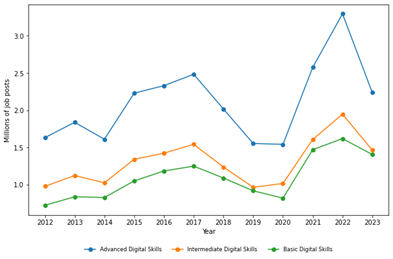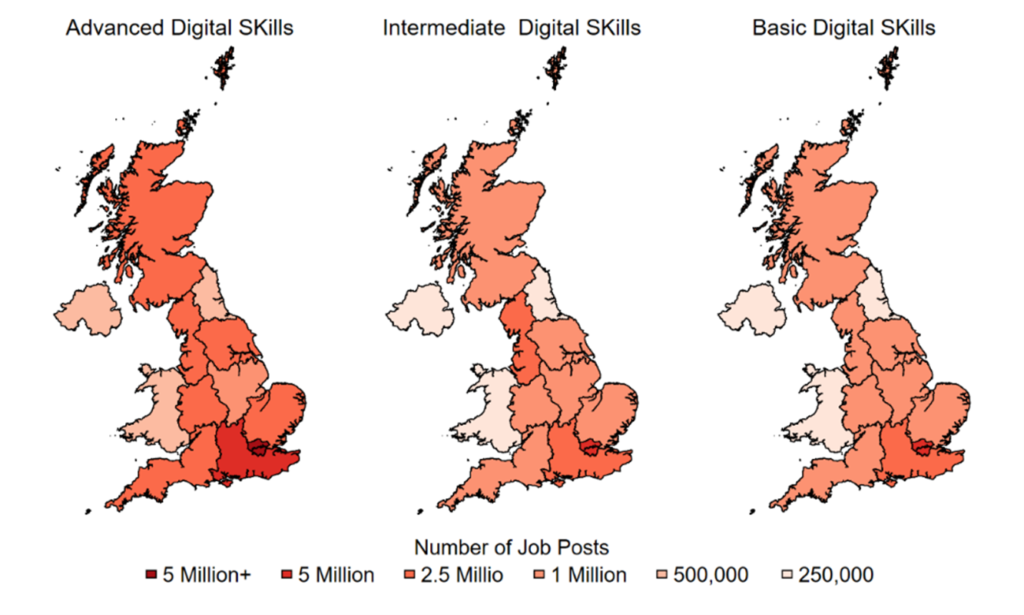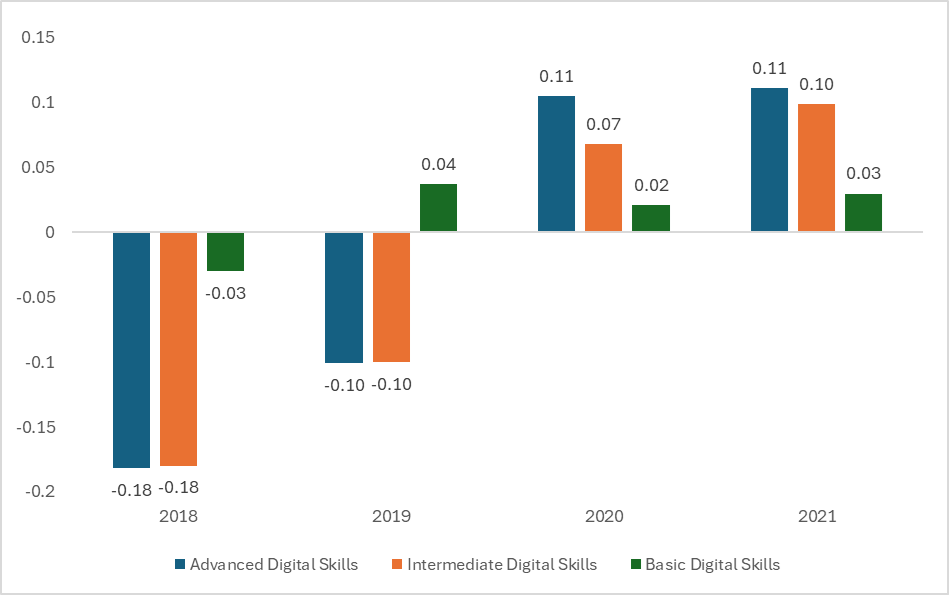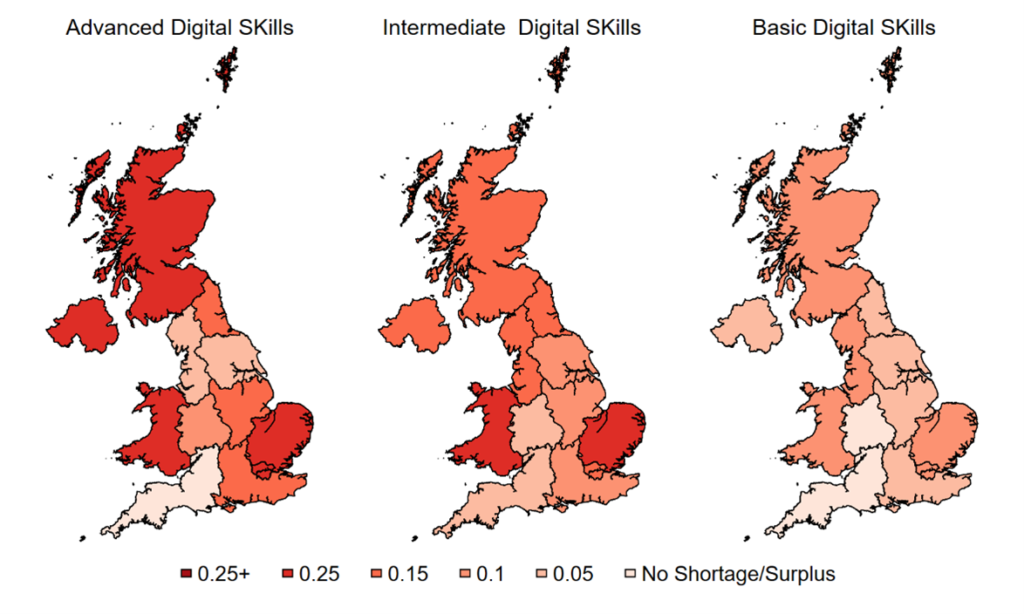
The UK has seen a dynamic evolution of the demand for digital skills over recent years, with a significant increase in the need for advanced, intermediate, and basic digital competencies across regions and occupations.
These changes reflect the rapid digitalisation of workplaces and the growing integration of technologies like artificial intelligence, cloud computing, and automation into various sectors. However, the supply of digital skills has not kept pace with this demand, resulting in acute shortages that vary by region and skill level.
These findings were presented by Dr Huanjia Ma, Dr Konstantinos Kollydas, Dr Matthew Lyons, and Professor Anne Green in a recent report on digital skills and the potential economic impact of digital skills shortages.
Context
The increasing integration of digital technologies into workplaces is revolutionising the skills required by employees across the UK. As the digital economy grows—contributing over £158 billion to the UK’s gross value added (GVA) in 2022—the demand for digital skills has never been more critical. New technologies such as Artificial Intelligence (AI) are on the rise, as reflected in the Government’s most recent AI Opportunities Action Plan. However, a persistent mismatch between supply and demand has led to significant digital skill shortages, posing challenges for regions, sectors, and occupations alike.
Digital Skills: A National Overview
Between 2012 and 2022, the demand for digital skills in job postings has grown substantially. In 2012, 2.4 million job postings in the UK required some level of digital skills; by 2022, this figure had climbed to nearly 3.7 million. Despite a dip in 2023, primarily due to a decrease in high-skill vacancies, the broader trend underscores a growing reliance on digital competencies across all sectors.
By classifying digital skills into advanced, intermediate, and basic levels using a Natural Language Processing (NLP) methodology, the analysis reveals that digital skills demand has fluctuated in line with the number of available vacancies, while still showing a clear upward trend. Notably, demand surged in 2021 and 2022, driven by the accelerated digital transformation and widespread adoption of remote work during the Covid-19 pandemic.
Advanced digital skills, such as programming and data analysis, account for the largest share of demand (see Figure 1). Intermediate skills, including the use of productivity tools like Power BI, show moderate but consistent demand. Basic skills, such as proficiency in Microsoft Office, exhibit the lowest explicit demand in job postings. However, this reflects their foundational nature, with possession of such skills often assumed rather than explicitly stated.
Figure 1: Millions of job posts requiring digital skills by level of skills – UK, 2012-2023

Regional and Occupational Variations in Demand
The demand for digital skills is not uniform across the UK. London and the South East lead in advanced digital skills demand, driven by their concentration of professional and information technology roles. In 2021, over 50% of vacancies requiring advanced skills originated in the Greater South East.
Outside London, regions and nations such as the North West and Scotland demonstrate increasing demand for advanced and intermediate skills, reflecting their diversification into technology-intensive industries. Conversely, regions like the North East report relatively low demand for advanced skills, underscoring regional disparities.
Figure 2: Number of Job Posts Requiring Basic, Intermediate, and Advanced Digital Skills in ITL 1 Regions – 2021

Professional roles, such as IT specialists and engineers, dominate the demand for advanced digital skills. However, occupations traditionally less reliant on digital skills—such as Skilled Trades and Process Operatives—are also experiencing rapid growth in digital skill requirements, illustrating the widespread digitalisation of processes and tools used by the workforce.
Emerging Trends in AI
Te nature of skills in demand is evolving, particularly with the rise of artificial intelligence (AI), cloud computing, and automation. Between 2012 and 2023, demand for AI-related skills increased tenfold. Furthermore, skills tailored for AI-related roles, such as Python programming and cloud technologies like Microsoft Azure and Amazon Web Services (AWS), have grown significantly in importance.
Digital technologies are also reshaping how people market, engage with stakeholders, and conduct everyday tasks. This integration into many everyday tasks has amplified the importance of digital marketing, content creation, and data management, reflecting the pervasive role of technology in all aspects of modern life.
Table 1: Top 10 Skills by Number of Appearances in Job Posts – UK, 2012 and 2023
| Top 10 Skills 2012 | Top 10 Skills 2023 | Classification |
| SQL (Programming Language) | Agile Methodology | Advanced
|
| C# (Programming Language) | Information Privacy | |
| JavaScript (Programming Language) | Automation | |
| Java (Programming Language) | SQL (Programming Language) | |
| Agile Methodology | Microsoft Azure | |
| HyperText Markup Language (HTML) | Python (Programming Language) | |
| Cascading Style Sheets (CSS) | Software Engineering | |
| ASP.NET | Amazon Web Services | |
| Linux | JavaScript (Programming Language) | |
| Software Development | Technical Support | |
| Telemarketing | SAP Applications | Intermediate |
| SAP Applications | Digital Marketing | |
| Help Desk Support | Power BI | |
| Information Technology Infrastructure Library | Help Desk Support | |
| Search Engine Optimization | Data Management | |
| Adobe Photoshop | Search Engine Optimization | |
| Digital Publishing | Salesforce | |
| Call Center Experience | Content Creation | |
| Digital Marketing | Call Center Experience | |
| Microsoft Access | Xero (Accounting Software) | |
| Microsoft Excel | Microsoft Excel | Basic |
| Computer Literacy | Microsoft Office | |
| Microsoft Office | Computer Literacy | |
| Microsoft Outlook | Microsoft Outlook | |
| Microsoft PowerPoint | Microsoft PowerPoint | |
| Firefox | Data Entry | |
| Microsoft Internet Explorer | Microsoft Word | |
| Safari (Web Browser) | Social Media | |
| Typing | Spreadsheets | |
| Microsoft Word | Typing |
Note: Table 5 in the report
Shortages in Digital Skills are evident
With the rapid growth in demand for digital skills, the supply has struggled to keep pace. Using the OECD methodology for deriving the Skills for Jobs indicator, the UK digital skills shortage indicator highlights a significantly high level of shortages across basic, intermediate, and advanced digital skills. This trend has been rising steadily since the onset of the Covid-19 pandemic in 2020. This is shown in Figure 3, where the larger the number, the higher the level of shortages.
Among the three levels of digital skills examined, advanced digital skills exhibit the highest level of shortages. However, the shortages in intermediate and basic digital skills remain substantial and should not be overlooked.
Figure 3: Digital Skills Shortage Indicators by Level of Digital Skills – UK, 2018 to 2021

Regional analyses reveal the most acute shortages in advanced digital skills in areas such as the East of England, London, and the devolved nations. Interestingly, these shortages do not always coincide with regions of highest demand, as lower demand in certain areas is partly a result of insufficient supply.
Wales and the East of England also face significant shortages in intermediate digital skills. While basic digital skills show milder shortages across the UK, the devolved nations and regions like the North East and the East of England still experience substantial gaps in this category.
Figure 4: Digital Skills Shortage Indicators by Region and Level of Digital Skills – 2021

The Need for Regionally Targeted Policies
The regional variation in demand and shortages reveals that areas with relatively lower demand, such as the devolved nations, often face disproportionately higher shortages. This suggests that low demand is partly driven by insufficient supply, which likely limits the ability of businesses to expand their operations or adopt technologies in those regions. This creates a cycle where inadequate supply discourages investment in key areas such as workforce development and technology adoption, which, in turn, further exacerbates regional disparities in digital transformation. This underscores the importance of targeted investments in training and digital infrastructure to build local talent pools and unlock growth potential. Supporting regions with lower demand but high shortages is crucial for fostering balanced development and ensuring the UK remains competitive in an increasingly digital economy.
This blog was written by Huanjia Ma, Research Fellow, Dr Matt Lyons, Research Fellow, Kostas Kollydas, Research Fellow, Anne Green, Professor of Regional Economic Development and Co-Director, at City-REDI, University of Birmingham.
Disclaimer:
The views expressed in this analysis post are those of the author and not necessarily those of City-REDI / WMREDI or the University of Birmingham.
